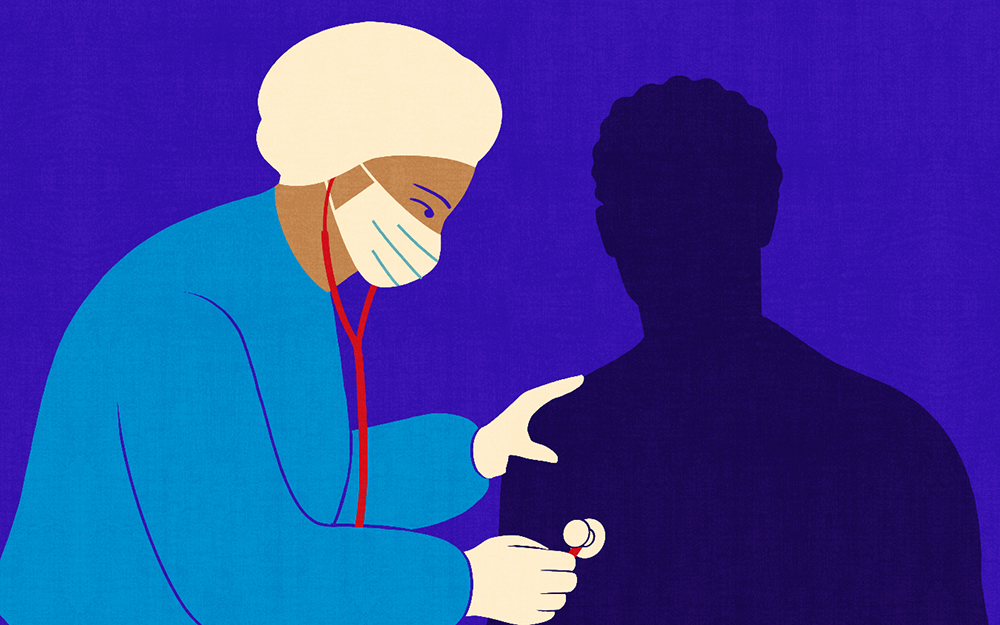Frontiers in Single-Cell Biology
Date
November 17, 2023
Credits

Date
November 17, 2023
Credits
Medical providers featured in this article
In Brief
{{cta-block}}
It’s nearly impossible to hear a vital message that’s whispered in the middle of a deafening crowd. This analogy is used by scientists looking to identify specific cancer cells in typical tissue samples. But now, first-in-class single-cell biologic technologies have made it possible to profile the key molecules of DNA, RNA and proteins—one cell at a time.
At the Cedars-Sinai Board of Governors Innovation Center (BOGIC), a team of multidisciplinary researchers and clinicians are identifying novel pathways to treat human disease. Jeffrey Golden, MD, who leads the groundbreaking initiative, explains that treating cardiovascular, neurodegenerative and genetic diseases, as well as most other diseases, begins by understanding each single cell. This cutting-edge research could lead to the advancement of cell therapies to treat conditions such as autism, Alzheimer’s disease, Parkinson’s disease, heart disease and all types of cancer.
Golden explains that in the early stages of creating the BOGIC, he and other key decision-makers wanted to focus their efforts on research that would have the greatest impact on science. With that goal in mind, they have created a one-of-a-kind, single-cell deep-phenotyping center.
We’re the first location that’s doing single-cell proteomics at this high discovery level.”
—Jeffrey Golden, MD
“We’re the first location that’s doing single-cell proteomics at this high discovery level,” said Golden, who is vice dean of Research and Graduate Education and director of the Burns and Allen Research Institute at Cedars-Sinai.
All this research is taking place under one roof in a collaborative environment. The BOGIC is able to dissect genomes and investigate the metabolome—the complete set of small-molecule chemicals found within a biological sample. Most importantly, all the research is focused on understanding human disease, leveraging the most advanced equipment in the world.
“We now have the capability to isolate, grow and screen different types of cells, beginning with a single cell and combining all the individual cells to understand complex multicellular tissues,” said Golden. “This allows us to develop therapeutic strategies that are only discoverable through single-cell biology.”
Golden said the BOGIC’s cancer investigations showcase the multifaceted applications of the new technology.
In Discoveries: New Tools at the Innovation Center
Attacking Cancer with CAR T-Cell Therapy
Oncologist Justin Darrah, MD, who is director of the CAR T-Cell Program and co-director of the Lymphoma Program at Cedars-Sinai, is collaborating with BOGIC scientists to use gene-modified cell therapy to treat patients with blood cancers.
“CAR T-cell therapy harnesses the patient’s own immune system to attack and kill the cancer,” Darrah said.
He explains that the treatment involves the infusion of a patient’s T-cells—a type of white blood cell—that have been modified by inserting chimeric antigen receptors (CARs), which are proteins engineered to direct the T-cells to a specific target.
“It’s a way of tricking the immune cells into thinking that the cancer is an infection. This therapy has proven to be very effective at treating hematologic malignancies,” he said, which include blood cancers such as multiple myeloma, acute lymphocytic leukemia and lymphoma.
Triggering the Immune System to Target Solid Tumors
While CAR T-cell therapy is effective for treating hematologic malignancies, this approach has not shown the same efficacy with solid mass tumors. However, such genetically modified cell therapies should be applicable to treat both liquid and solid tumors by summoning the immune system as the catalyst for healing.
“Tumors are made up of many different kinds of cells, not just cancer cells,” said Sarah Parker, PhD, who is co-director of the Proteomics and Metabolomics Core at Cedars-Sinai and a leader of proteomic technology development at the BOGIC.
“But now we have evidence that we can turn on the immune system to recognize and attack only the cancer cells. There have been several convincing studies showing that this is a way to target and clear out certain kinds of cancers,” said Parker. She is collaborating on a brain tumor study with Joshua Breunig, PhD, who is director of the Brain Program at Cedars-Sinai’s Board of Governors Regenerative Medicine Institute.
In their shared project, Breunig develops a system for identifying the immune-triggering peptides on tumor cells using a model of brain cancer. Then Parker uses her expertise in proteomics to sequence the data. Using a new million-dollar mass spectrometer and a technique called immunopeptidomics, they’re able to find tumor neoantigens, which are proteins that form on cancer cells. Breunig is making models that reflect the diversity of patients’ tumor subtypes, with the goal of creating new immunotherapies to recognize and eradicate brain tumor cells.
“Our objective is to discover what tumors are expressing that don’t exist in normal cells, such as neoepitopes, which are small peptides that are specific to tumor cells and that the immune system doesn’t recognize,” Breunig said. “That way we can target the cancer without harming the rest of the body.”
“We’re developing single-cell proteomic technology to study just the proteins in one cell at a time,” added Parker, “and we’re doing some really groundbreaking work.”
Engineering Stem Cells Into Living Medicine
Dhruv Sareen, PhD, who is executive director of the Cedars-Sinai Biomanufacturing Center (CBC) and founding director of the Induced Pluripotent Stem Cell (iPSC) Core at the Regenerative Medicine Institute, is a key collaborator on cell-therapy research for treating cancer and other diseases.
From his Biomanufacturing Center lab, Sareen is working with Darrah to provide autologous CAR T-cell therapy to blood cancer patients using their own blood cells. In order to scale these innovative life-changing therapies to other patients, the team aims to use an allogeneic process involving a healthy donor’s stem cells to combat carcinomas (solid tumors).
In his research with Parker and Breunig in the BOGIC, Sareen explained that the process begins when specific target proteins are engineered into reprogrammed stem cells, called iPSCs, which are then “forward” programmed into specific cell types through differentiation.
“Once the discovery is complete and we engineer the target proteins (in iPSCs) that are only expressed in brain tumor cells, such as glioblastoma, we can make novel, designer CAR T-cells in unlimited quantities, which essentially function as living medicines in the patient’s body to target and destroy the solid tumors,” said Sareen.
In Discoveries: Regenerative Medicine: A New Path for ALS Treatment
Discovering Novel Treatments for Personalized Patient Care
Helping patients today and in the future begins with the innovative discoveries made in the lab. By focusing research on the single cell, giant leaps forward are possible.
“Cell-based technologies will allow us to identify new targets for the treatment of cancer and many other diseases,” Golden said. “The BOGIC is enabling discovery that was not possible just a few years ago and will permit discovery not yet imagined today.”





